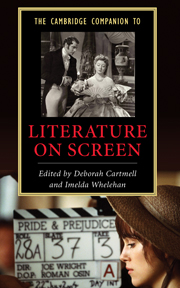Book contents
- Frontmatter
- Introduction - Literature on screen: a synoptic view
- Part One Theories of Literature on Screen
- Part Two History and Contexts
- 3 Gospel narratives on silent film
- 4 William Shakespeare, filmmaker
- 5 The nineteenth-century novel on film: Jane Austen
- 6 Modernism and adaptation
- 7 Postmodern adaptation: pastiche, intertextuality and re-functioning
- Part Three Genre, Industry, Taste
- Part Four Beyond the "Literary"
- Further reading
- Index
- Series List
6 - Modernism and adaptation
from Part Two - History and Contexts
Published online by Cambridge University Press: 28 September 2007
- Frontmatter
- Introduction - Literature on screen: a synoptic view
- Part One Theories of Literature on Screen
- Part Two History and Contexts
- 3 Gospel narratives on silent film
- 4 William Shakespeare, filmmaker
- 5 The nineteenth-century novel on film: Jane Austen
- 6 Modernism and adaptation
- 7 Postmodern adaptation: pastiche, intertextuality and re-functioning
- Part Three Genre, Industry, Taste
- Part Four Beyond the "Literary"
- Further reading
- Index
- Series List
Summary
Film adaptation has always had a love-hate relationship with literary modernism. A creative union seemed almost certain in the 1910s and 1920s, though. Modernist writers were fascinated with visual media; German theorist Walter Benjamin proclaimed film the definitive modern form; and the modernist magazine Close Up (1927-33) was forging aesthetic links between film and literary culture “from the angles of art, experiment, and possibility.” The energies of literary and cinematic modernism in the years either side of World War I promised an imaginative movement beyond the limits of written and visual forms. Many modernist writers could be “profoundly cinematic even when not fully cognizant of it”; filmmakers such as D. W. Griffith, Georges Méliès and Eric von Stroheim were drawn to the written word because it lent early cinema aesthetic validity; and two 1928 versions of The Fall of the House of Usher by French director Jean Epstein and American team James Sibley Watson Jr. and Melville Webber showed what could be achieved by transforming Edgar Allan Poe's gothic tale into visually provocative cinema.
However, when it comes to cinematic adaptations of modernist fiction filmmakers have often found themselves faced with major technical problems. Critics Gilberto Perez and Sam Girgus have argued that these problems derive from the way in which modernist culture exacerbates the tension between film as a “reflective” form (representing and documenting) and a “creative” medium (reworking and transforming).
- Type
- Chapter
- Information
- The Cambridge Companion to Literature on Screen , pp. 90 - 106Publisher: Cambridge University PressPrint publication year: 2007
- 2
- Cited by

